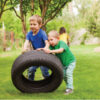by Tara Highway
Swimming Squidz
The earlier you can begin a child’s swimming journey, the better that journey will be! Many start when only a few weeks old, which is ideal. My own three children began swimming at about two months old and have had a real passion for swimming and the water ever since.
The idea at a young age, is to grow awareness of the water, learn safety skills and ignite a love for the water. The journey begins as a very sensory one. One, we as instructors and parents need to be very in tune with. It is a slow process during which we must learn to listen to each individual baby/toddler and work to their own needs. One baby may excel, another may struggle with the whole process – what we need to do as instructors and professionals is see and understand their fears and anxieties and then work along side the parent/carer to help them work through their fears. Often, the anxieties and fears are passed through from the parent, so you are not only starting the work with the baby but, on a regular basis, you are helping work on the parent/guardians worries too. Adult anxieties can often stem from a childhood trauma or sometimes there is no trigger, just an ‘irrational fear’.
So, beginning as early as you are able to is paramount for a child’s early safety awareness and confidence in the water, be it a bath, swimming pool, the sea or a river. It also helps them not gain a fear of the water from the outset.
We start them with a cue, so they can relate the words to know what is about to happen. This can be a simple trickle of water over their head, with a ‘Ready go’ command helping them learn to understand it means they are about to get wet. The most important thing is to make it fun, even if they have their own worries. It is so important that the parent or carer shows a huge smile and lots of positive noises, so the baby or toddler understands there is nothing to fear and it is all great fun!
Learning how to blow bubbles is important for their onward learning and planting the idea about learning breathing skills. So we demonstrate bubble blowing by blowing them ourselves – all children find bubbles funny and us doing it often make them chuckle. They need to learn how to blow bubbles and in this way they slowly start trying to mirror what we are doing which is a fun activity for all involved.
For early years learning in the water the key element is fun and enjoyment. It is made more enjoyable involving themes, especially toddler age, from unicorns, tools, space, pirates, flowers, building, Christmas, Easter and so on – different themes keep interest and excitement in the learning. Whether they are working on arm or leg movements, turning, diving, working with noodles, floats or on a big mat, there are so many fun ways to learn in the water, so much so, they think they are just playing and having fun, but they are learning an incredible amount more! For a simple example, if they are on noodle ‘seahorses’ it is the start of them learning about balance, core strength and treading water – what a skill to have!
If you are unable to start them off at an early age, don’t worry that is no problem, things are not always in the right place for an early start. A later start can cause a fear of water or an over confidence, both can be problematic, but equally, it will be fine with the right instructor. It is being able to (as an instructor) ‘curb’ the over confidence, without taking away or ruining the passion and joy of the water or learning. In equal measures, helping an older child (four and above) find their love for the water can be so rewarding as it can be a long journey with many blips along the way.
Every child learns at their own pace but you also have to factor in any special need as these can be very complex. Making sure you understand these needs is all part of your ability to teach successfully, to help each and every child. All these things need to be taken in to account when teaching a confident child, or a very anxious child. Remember, start at the basics and work from there, work to each child’s ability, not what you think is ‘expected’. It is incredibly important to stop and remind yourself that what one child will find easy another may not – finding the way forward to help and encourage their love for water is always a priority. Keeping a routine is what the children like, repetition is key, and we all learn from routine.
Growing a firm bond with each child is a huge step in their confidence, they need to know they can fully trust you in the water, know you will keep them safe. Making absolutely sure they all know, on an individual basis, that what they have achieved no matter how big or small, is fantastic, they need to leave every lesson knowing how well they have done and how proud you are of them. Ending every session with a fun activity is always such a reward for all the children and us as instructors, seeing how happy they are after a great session in the water. One of the mantras in my lessons is always “I can do it, I AM AMAZING.”
There is sadly still a massive proportion of children who have no knowledge or skills in the water at all – this is something that needs to change and soon. Swimming and basic water safety skills are imperative for everyone – it could one day save your child’s life
So, why not find your local swim school and book lessons now?
Swimming Squidz, is a family run business teaching babies and children up to the age of 11 to love the water while staying safe. www.swimmingsquidz.co.uk






 PANTS stands for:
PANTS stands for:












